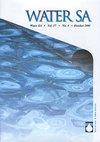利用SPI和SPEI对南非西开普省两个农业区的基线概率和季节性干旱进行预测
IF 1.2
4区 环境科学与生态学
Q4 WATER RESOURCES
引用次数: 0
摘要
就直接受影响的人数而言,干旱是最危险的自然灾害之一。干旱的一个重要特征是相对于长期平均水平,长时间缺乏降雨。干旱条件从一个月持续到下一个月的内在持续性可以用于干旱监测和预警系统。这项研究试图更好地了解南非西开普省两个农业上重要的降雨地区的干旱概率和基线——一个有独特的降雨季节,另一个全年降雨。通过对标准化降水和蒸散指数(SPEI)和标准化降水指数(SPI)进行评估,获得预测信息,建立干旱基线概率。使用了两组合成时间序列数据(一组保留季节性,另一组去除季节性),以及月降雨量和最低和最高温度的观测数据。基于SPI固有的持续特性,利用自相关得到了SPI各启动和提前期未来状态的概率密度函数。并建立了最优持久性。然后通过应用于最近的开普敦干旱(2015-2018)来检验该方法的有效性。结果表明,该方法有潜力应用于该省的干旱预警系统和决策支持工具。本文章由计算机程序翻译,如有差异,请以英文原文为准。
Using SPI and SPEI for baseline probabilities and seasonal drought prediction in two agricultural regions of the Western Cape, South Africa
Drought is one of the most hazardous natural disasters in terms of the number of people directly affected. An important characteristic of drought is the prolonged absence of rainfall relative to the long-term average. The intrinsic persistence of drought conditions continuing from one month to the next can be utilized for drought monitoring and early warning systems. This study sought to better understand drought probabilities and baselines for two agriculturally important rainfall regions in the Western Cape, South Africa – one with a distinct rainfall season and one which receives year-round rainfall. The drought indices, Standardised Precipitation and Evapotranspiration Index (SPEI) and Standardised Precipitation Index (SPI), were assessed to obtain predictive information and establish a set of baseline probabilities for drought. Two sets of synthetic time-series data were used (one where seasonality was retained and one where seasonality was removed), along with observed data of monthly rainfall and minimum and maximum temperature. Based on the inherent persistence characteristics, autocorrelation was used to obtain a probability density function of the future state of the various SPI start and lead times. Optimal persistence was also established. The validity of the methodology was then examined by application to the recent Cape Town drought (2015–2018). Results showed potential for this methodology to be applied in drought early warning systems and decision support tools for the province.
求助全文
通过发布文献求助,成功后即可免费获取论文全文。
去求助
来源期刊

Water SA
环境科学-水资源
CiteScore
2.80
自引率
6.70%
发文量
46
审稿时长
18-36 weeks
期刊介绍:
WaterSA publishes refereed, original work in all branches of water science, technology and engineering. This includes water resources development; the hydrological cycle; surface hydrology; geohydrology and hydrometeorology; limnology; salinisation; treatment and management of municipal and industrial water and wastewater; treatment and disposal of sewage sludge; environmental pollution control; water quality and treatment; aquaculture in terms of its impact on the water resource; agricultural water science; etc.
Water SA is the WRC’s accredited scientific journal which contains original research articles and review articles on all aspects of water science, technology, engineering and policy. Water SA has been in publication since 1975 and includes articles from both local and international authors. The journal is issued quarterly (4 editions per year).
 求助内容:
求助内容: 应助结果提醒方式:
应助结果提醒方式:


